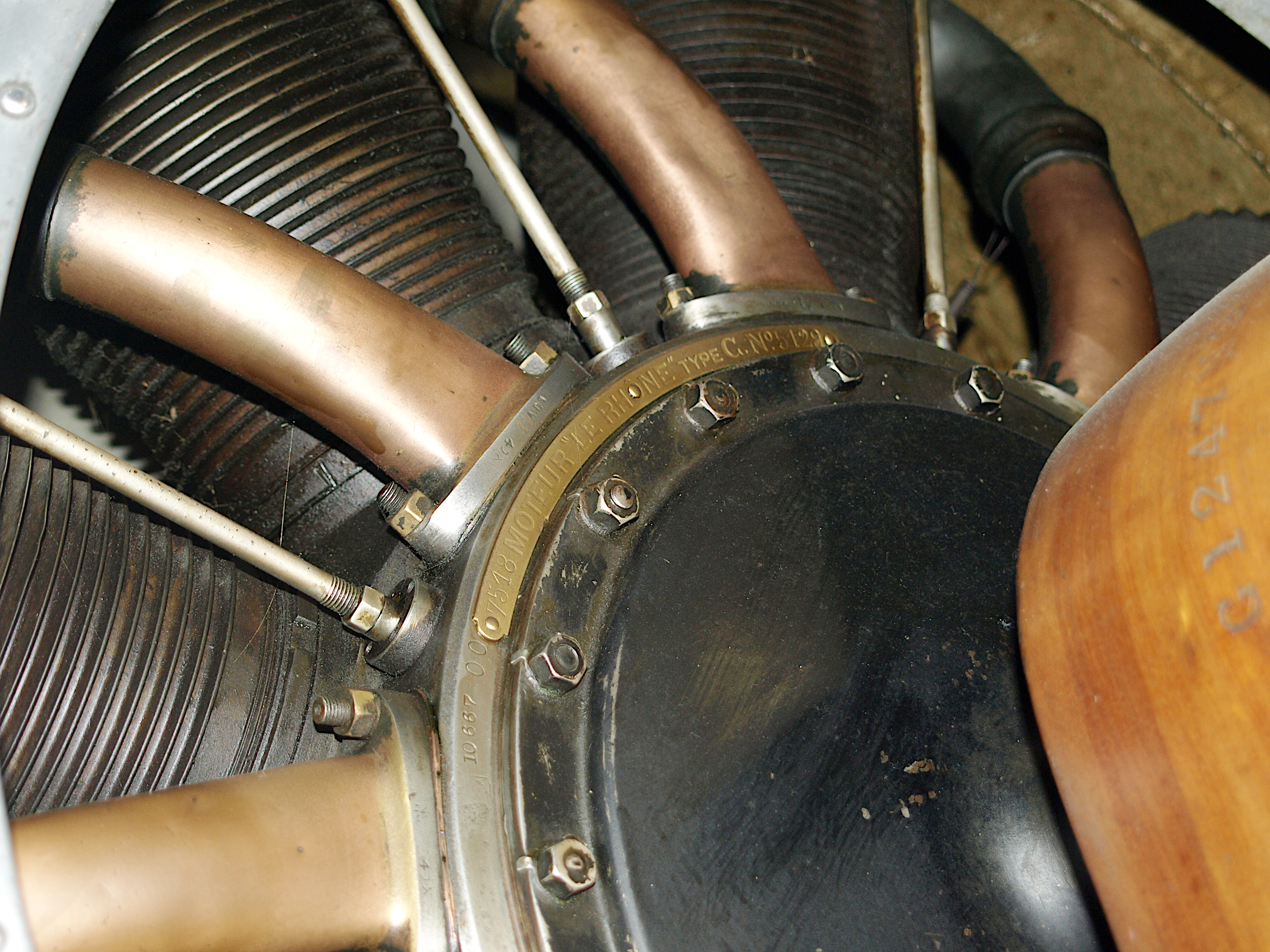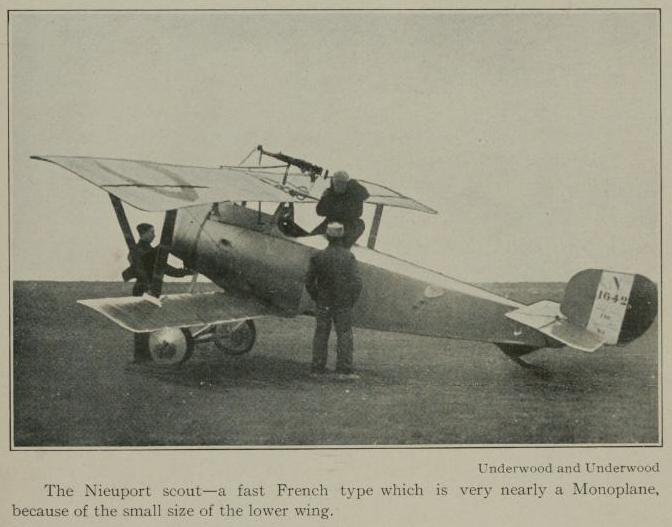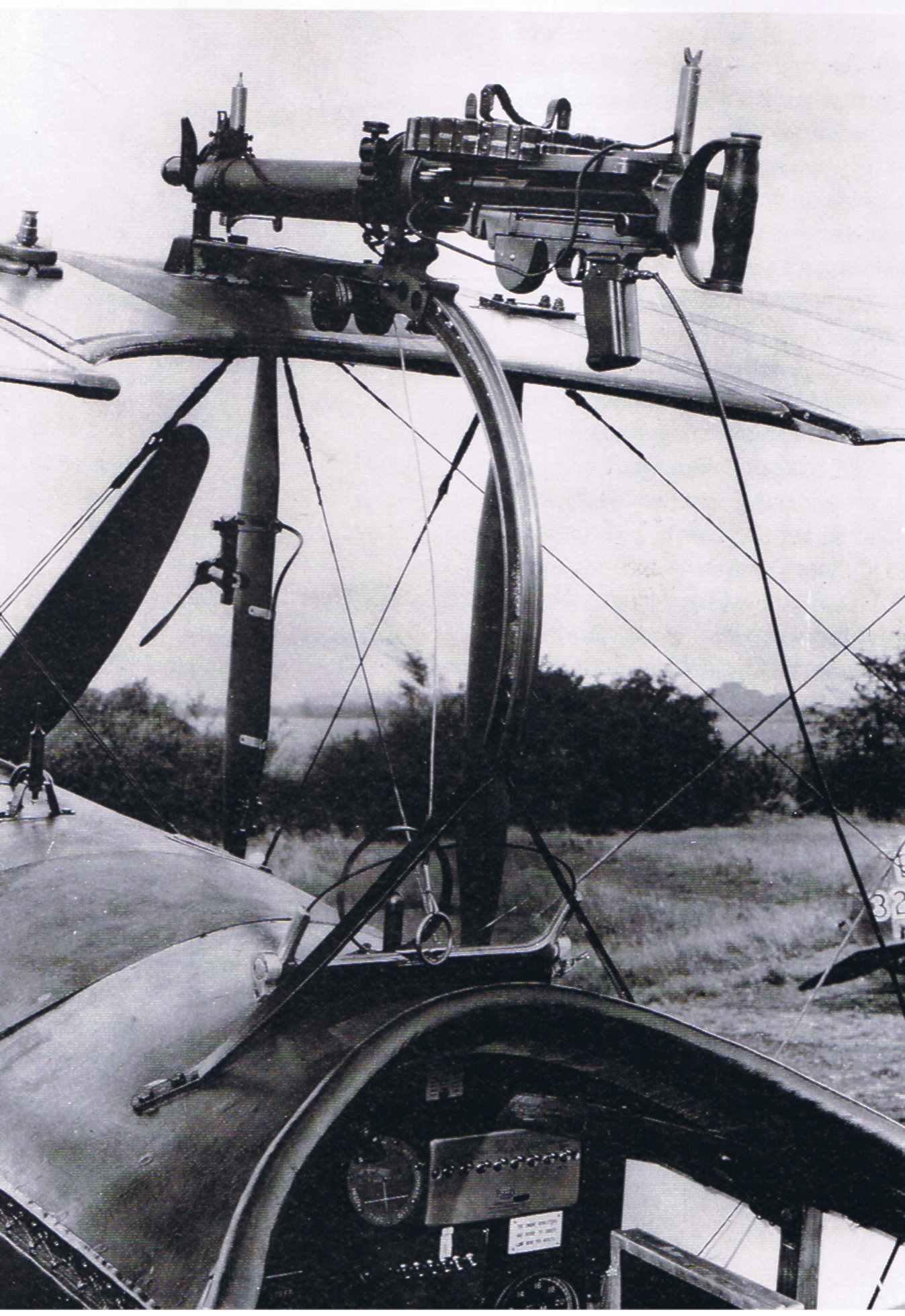|
Nieuport XXVII
The Nieuport 27 (or Nieuport XXVII C.1 in contemporary sources) was a World War I French sesquiplane fighter aircraft designed by Gustave Delage. The 27 was the last of the line of Nieuport "V-strut" single seat fighters that began with the Nieuport 10 of 1914. Operational examples supplemented the very similar Nieuport 24 and 24bis in operational squadrons in late 1917 and many would also be used as advanced trainers. Design and development The Nieuport 27's design closely followed that of the 24, sharing the same faired fuselage, rounded ailerons and half-heart shaped rudder.Davilla, 1997, p.400 The only externally visible changes from the 24 included the replacement of the fixed external wood Nieuport type sprung tailskid with an internally pivoted type, and the replacement of the single undercarriage axle that connected both wheels, with one that had a hinge along the centerline – and one extra wire. By 1918, many Nieuport fighters were being used as advanced trainers, ... [...More Info...] [...Related Items...] OR: [Wikipedia] [Google] [Baidu] |
WikiProject Aircraft
A WikiProject, or Wikiproject, is an affinity group for contributors with shared goals within the Wikimedia movement. WikiProjects are prevalent within the largest wiki, Wikipedia, and exist to varying degrees within Wikimedia project, sibling projects such as Wiktionary, Wikiquote, Wikidata, and Wikisource. They also exist in different languages, and translation of articles is a form of their collaboration. During the COVID-19 pandemic, CBS News noted the role of Wikipedia's WikiProject Medicine in maintaining the accuracy of articles related to the disease. Another WikiProject that has drawn attention is WikiProject Women Scientists, which was profiled by ''Smithsonian Magazine, Smithsonian'' for its efforts to improve coverage of women scientists which the profile noted had "helped increase the number of female scientists on Wikipedia from around 1,600 to over 5,000". On Wikipedia Some Wikipedia WikiProjects are substantial enough to engage in cooperative activities with outsi ... [...More Info...] [...Related Items...] OR: [Wikipedia] [Google] [Baidu] |
Le Rhône 9C
The Le Rhône 9C is a nine-cylinder Rotary engine, rotary aircraft engine produced in France by '' Société des Moteurs Le Rhône'' / Gnome et Rhône. Also known as the Le Rhône 80 hp in a reference to its nominal power rating, the engine was fitted to many military aircraft types during the World War I, First World War. Le Rhône 9C engines were also produced under license in Great Britain, the United States and Sweden. Design and development First marketed in 1912, the 80 horsepower 9C was the first of the Le Rhône, Rhône series rotary engines to have nine cylinders. In common with earlier seven cylinder Le Rhône series engines, the 9C featured copper Inlet manifold, induction pipes and used a single push-pull rod to operate its two Overhead valve, overhead valves. Unlike the later 110 horsepower 9J, the induction pipes and push rods were located on the front of the engine. Prior to the outbreak of World War One, aircraft powered by the Rhône 9C set nume ... [...More Info...] [...Related Items...] OR: [Wikipedia] [Google] [Baidu] |
First World War
World War I or the First World War (28 July 1914 – 11 November 1918), also known as the Great War, was a World war, global conflict between two coalitions: the Allies of World War I, Allies (or Entente) and the Central Powers. Fighting took place mainly in European theatre of World War I, Europe and the Middle Eastern theatre of World War I, Middle East, as well as in parts of African theatre of World War I, Africa and the Asian and Pacific theatre of World War I, Asia-Pacific, and in Europe was characterised by trench warfare; the widespread use of Artillery of World War I, artillery, machine guns, and Chemical weapons in World War I, chemical weapons (gas); and the introductions of Tanks in World War I, tanks and Aviation in World War I, aircraft. World War I was one of the List of wars by death toll, deadliest conflicts in history, resulting in an estimated World War I casualties, 10 million military dead and more than 20 million wounded, plus some 10 million civilian de ... [...More Info...] [...Related Items...] OR: [Wikipedia] [Google] [Baidu] |
Champs Élysées
Champs may refer to: Music * The Champs, a U.S. instrumental music group * Champs (Brazilian band), a Brazilian boy band * Champs (British band), a British folk- and indie rock-influenced band * The Fucking Champs, a U.S. progressive heavy metal band previously known as The Champs * "Champs", a song on Wire's 1977 album ''Pink Flag'' Places in France * Champs, Aisne, in the Aisne ''département'' * Champs, Orne, in the Orne ''département'' * Champs, Puy-de-Dôme, in the Puy-de-Dôme ''département'' * Champs-Romain, in the Dordogne ''département'' * Champs-sur-Marne, in the Seine-et-Marne ''département'' * Champs-sur-Tarentaine-Marchal, in the Cantal ''département'' * Champs-sur-Yonne, in the Yonne ''département'' * Les Champs-de-Losque, in the Calvados ''département'' * Champs-Élysées, literally the "Elysian fields", a broad avenue in Paris Sport * Champs (brand), a Brazilian sporting goods manufacturer * Champs Sports, a subsidiary of Foot Locker, Inc. ... [...More Info...] [...Related Items...] OR: [Wikipedia] [Google] [Baidu] |
Nieuport 27 Drawing
Nieuport, later Nieuport-Delage, was a French aeroplane company that primarily built racing aircraft before World War I and fighter aircraft during World War I and between the wars. History Beginnings Originally formed as Nieuport-Duplex in 1902 for the manufacture of engine components the company was reformed in 1909 as the Société Générale d'Aéro-locomotion, and its products were marketed to the aviation industry, including ignition components. During this time they built their first aircraft, a small single-seat pod and boom monoplane. This was destroyed shortly after having been flown successfully, during the Great Flood of Paris in 1909 . A second design flew before the end of 1909 and had the essential form of modern aircraft, including an enclosed fuselage with the pilot protected from the slipstream and a horizontal tail whose aerodynamic force acted downwards, balancing the weight of the engine ahead of the centre of gravity, as opposed to upwards as on contempo ... [...More Info...] [...Related Items...] OR: [Wikipedia] [Google] [Baidu] |
Godefroy Flight
Godefroy is a surname of Old French origin, and originally a given name, cognate with Geoffrey/Geoffroy/ Jeffrey/Jeffries, Godfrey, Gottfried, etc. Godefroy or Godefroi may refer to: People Given name * Godefroi, Count of Durbuy (d. before 1124), son of Henry I * Godefroi, Count of Montaigu (died 1161), Count of Clermont, Count of Duras * Godefroi, Comte d'Estrades (1607–1686), French diplomat and marshal * Godefroi, prince de La Tour d'Auvergne-Lauraguais (1823–1871), French politician * Godefroy de Blonay (1869–1937), a member of the International Olympic Committee and one of the founders and first president of the Swiss Olympic Association * Godefroy Calès (1799–1868), French physician and politician * Éléonore-Louis Godefroi Cavaignac (1801–1845), French politician and journalist * Godefroy de Forçant (died 1809), French Navy officer and adventurer * Godefroy Durand (1832–1896), German-born French illustrator and draughtsman * Godefroy Engelmann ... [...More Info...] [...Related Items...] OR: [Wikipedia] [Google] [Baidu] |
Nieuport 28
The Nieuport 28 C.1, a French biplane fighter aircraft flown during World War I, was built by Nieuport and designed by Gustave Delage. Owing its lineage to the successful line of sesquiplane fighters that included the Nieuport 17, the Nieuport 28 continued a similar design philosophy of a lightweight and highly maneuverable aircraft. By the time the Nieuport 28 was available, the SPAD XIII had been chosen to equip the ''escadrilles de chasse'' of the Aéronautique Militaire for 1918, and this fighter was also the first choice for the projected American "pursuit" squadrons. In the event, a shortage of SPADs led to Nieuport 28s being issued to four American squadrons between March and August 1918, becoming the first aircraft to see operational service with an American fighter squadron. Nieuport 28s saw considerable post-war service: in particular 50 from a later production run were shipped to America, and as well as army and naval service these found civilian use, especially ... [...More Info...] [...Related Items...] OR: [Wikipedia] [Google] [Baidu] |
Nieuport 26
Nieuport, later Nieuport-Delage, was a French aeroplane company that primarily built racing aircraft before World War I and fighter aircraft during World War I and between the wars. History Beginnings Originally formed as Nieuport-Duplex in 1902 for the manufacture of engine components the company was reformed in 1909 as the Société Générale d'Aéro-locomotion, and its products were marketed to the aviation industry, including ignition components. During this time they built their first aircraft, a small single-seat pod and boom monoplane. This was destroyed shortly after having been flown successfully, during the Great Flood of Paris in 1909 . A second design flew before the end of 1909 and had the essential form of modern aircraft, including an enclosed fuselage with the pilot protected from the slipstream and a horizontal tail whose aerodynamic force acted downwards, balancing the weight of the engine ahead of the centre of gravity, as opposed to upwards as on contempo ... [...More Info...] [...Related Items...] OR: [Wikipedia] [Google] [Baidu] |
Hispano-Suiza 8
The Hispano-Suiza 8 is a Internal combustion engine cooling, water-cooled V8 engine, V8 SOHC aero engine introduced by Hispano-Suiza in 1914 that went on to become the most commonly used liquid-cooled engine in the aircraft of the Entente Powers during the First World War. The original Hispano-Suiza 8A was rated at and the later, larger displacement Hispano-Suiza 8F reached . Hispano-Suiza 8 engines and variants produced by Hispano-Suiza and other companies under licence were built in twenty-one factories in Spain, France, Britain, Italy, and the U.S. Derivatives of the engine were also used abroad to power numerous aircraft types and the engine can be considered as the ancestor of another successful engine by the same designer, the Hispano-Suiza 12Y (and Soviet Klimov V12 derivative aero-engines) which was in service during the Second World War. Design and development Origins At the beginning of World War I, the production lines of the Barcelona based Hispano-Suiza automobil ... [...More Info...] [...Related Items...] OR: [Wikipedia] [Google] [Baidu] |
Foster Mounting
The Foster mounting was a device fitted to some fighter aircraft of the Royal Flying Corps during the First World War. It was designed to enable a machine gun (in practice, a Lewis Gun) to fire ''over'', rather than ''through'' the arc of the spinning propeller. It took several forms when applied to different aircraft types, but all shared the feature of a quadrant-shaped I-beam rail on which the gun could slide back and down in one movement. The primary purpose was to facilitate the changing of spent ammunition drums, but some pilots also found that the mounting permitted the gun to be fired directly upward or at an angle, permitting a fighter aircraft to attack an opponent from beneath. Background Before the ready availability of a reliable synchronization gear, several methods were tried to mount a machine gun in a position from which it would be able to fire ''past'' rather than ''through'' the arc of the propeller.Cheesman 1960, p. 176. Even after reasonably reliable synchr ... [...More Info...] [...Related Items...] OR: [Wikipedia] [Google] [Baidu] |
Royal Air Force
The Royal Air Force (RAF) is the Air force, air and space force of the United Kingdom, British Overseas Territories and Crown Dependencies. It was formed towards the end of the World War I, First World War on 1 April 1918, on the merger of the Royal Flying Corps (RFC) and the Royal Naval Air Service (RNAS). Following the Allies of World War I, Allied victory over the Central Powers in 1918, the RAF emerged as the largest air force in the world at the time. Since its formation, the RAF has played History of the Royal Air Force, a significant role in Military history of the United Kingdom, British military history. In particular, during the Second World War, the RAF established Air supremacy, air superiority over Nazi Germany's Luftwaffe during the Battle of Britain, and led the Allied strategic bombing effort. The RAF's mission is to support the objectives of the British Ministry of Defence (United Kingdom), Ministry of Defence (MOD), which are to "provide the capabilities nee ... [...More Info...] [...Related Items...] OR: [Wikipedia] [Google] [Baidu] |






